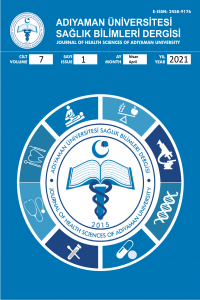DİABETİK AYAKTA TEDAVİ YAKLAŞIMLARI VE WAGNER SINIFLAMASININ TEDAVİYİ YÖNLENDİRMEDEKİ ROLÜ
Diabetik ayak, Wagner sınıflaması
THE TREATMENT APPROACHES IN DIABETIC FOOT AND THE ROLE OF WAGNER CLASSIFICATION IN THE GUIDANCE OF TREATMENT
Diabetic foot, Wagner classification,
___
- 1. Baktıroğlu S. Cerrahi infeksiyon. in: Sayek İ. (ed). Diyabet ve infeksiyon. Ankara: Güneş Kitabevi, 2000: 64-73.
- 2. Başkal N, Güllü S, Ilgın ŞD, Erdoğan G. Evaluation of the patients with diabetic foot ulcerations. Turkish Journal of End Metab 1998; 2 (1): 31-35.
- 3. Ünlühızarcı K, Doğanay M, Keleştimur F. Diabetik ayak infeksiyonları. Türk Diyabet Yıllığı 1995; 6: 98-102.
- 4. Snyder A.J., Robbins M.J. Lower extremity amputations: basis and outcome, a review of the literature. Journal of Foot and Ankle Surgery 1993; 32: 60- 68.
- 5. Humphrey A.G, Dowse G.K, Thoma K. Diabetes and non-traumatic lower extremity amputations. Diabetes Сare 1996; 19: 710-714.
- 6. Lehto S., Rönnemaa T., Pyorala K. Risk factors predicting lower extremity amputations in patients with NIDDM. Diabetes Care 1996; 19: 607-611.
- 7. Trautner C, Haastert B, Giani G. Incidence of lower limb amputations and diabetes. Diabetes Care 1996; 19: 1006-1009.
- 8. Rooh-Ul-Muqim, Ahmed M, Griffin S. Evaluation and management of diabetic foot according to Wagner's classification. A study of 100 cases. J Ayub Med Coll Abbottabad 2003; 15(3): 39-42.
- 9. Dinççağ A, Baktıroğlu S, Dinççağ N. Diyabetik ayak: Amputasyon önlenebilir mi? İst Tıp Fak Mecmuası 1999; 62: 1-11.
- 10. Bostanoğlu S, Erverdi N, Karabulut Z et al. Diyabetik ayak ve amputasyonu: risk faktörleri ve risk skorlamasının önemi. İnsizyon 2000; 3: 201-206.
- 11. Helm PA, Walker SC, Pullium G. Total contact casting in diabetic patients with neuropatic foot ulcerations. Arch. Phys. Med. Rehabil 1984: 65: 691-693.
- 12. Cervantes-García E, Salazar-Schettino PM. Clinical and surgical characteristics of infected diabetic foot ulcers in a tertiary hospital of Mexico. Diabet Foot Ankle 2017; 8(1): 1367210.
- 13. Wutschert R, Bounameaux H. Determination of amputation level in ischemic limbs. Diabetes Care 1997; 20: 1315-1318.
- 14. Bames R, Thomhill B, Nix L. Predicting of amputation wound Healing: roles of Doppler ultrasound and digit photoplethysmography. Arch Surgery 1998; 116: 80-83.
- 15. Hill SL, Holtzman GI, Buse R et al. The effect of peripheral vascular disease with osteomyelitis in the diabetic foot. Am J Surg 1999; 177: 282-286.
- 16. Raşa K. Diyabetik ayakta tanı ve tedavi yaklaşımları, in: Erdoğan B.(ed). Diyabetik ayak hastalarında cerrahi tedavi. Ankara: DTP Basımevi 2000: 33- 39.
- 17. Bridges RM, Deitch EA. Diabetic foot infections. Surg Clin North Am. 1994; 74 (3): 537-555.
- 18. Apelquist J, Castenfors J. Larsson J. Prognostic value of systolic ankle and blood pressure levels in outcome of diabetic foot ulcer. Diabetes Care 1989; 12: 373-378.
- 19. Umeh L, Wallhagen M, Nicoloff N. Identifying diabetic patients at high risk for amputation. Nurse Pract 1999; 24 (8): 56-70.
- 20. New JP, Mc Doneli D. Bıırns E. Young RJ. Problem of amputations in patients with newly diagnosed diabetes mellitus. Diab Med 1998; 15 (99): 760-764.
- 21. Sun JH, Tsai JS, Huang CH, Lin CH, Yang HM, Chan YS, Hsieh SH, Hsu BR, Huang YY. Risk factors for lower extremity amputation in diabetic foot disease categorized by Wagner classification. Diabetes Res Clin Pract. 2012; 95(3): 358-63.
- 22. West NJ. Systemic antimicrobial treatment of foot infections in diabetic patients. Am J Health Syst Pharm 1995; 52: 1199-1202.
- 23. Jeffcoate WJ, Harding KG. Diabetic foot ulcers. The Lancet 2003: 361(9368): 1545- 1551.
- 24. Akalın EH. Direct medical cost analysis in patients with diabetes mellitus in Turkey. Turkish Journal of Endocrinology and Metabolism 1998; 1: 9-14.
- Yayın Aralığı: Yılda 3 Sayı
- Başlangıç: 2015
- Yayıncı: ADIYAMAN ÜNİVERSİTESİ
Yaşlı Hastalarda Uygunsuz İlaç Kullanımının İncelenmesi ve Polifarmasi Varlığı
Erhan BOZKURT, Ali PARLAR, Seyfullah Oktay ARSLAN
HbA1c Testi için Maliyet Etkinlik Değerlendirmesi
Mehmet ÖZDİN, Hayrullah YAZAR, Durhasan MUNDAN
HEMŞİRELERİN CERRAHİ HASTASININ BESLENMESİ KONUSUNDA BİLGİ, TUTUM VE UYGULAMALARININ İNCELENMESİ
Sistemik sklerozis ve sjögren sendromu olan hastada off-pump koroner arter baypas greft cerrahisi
Arda Aybars PALA, Temmuz TANER, Ahmet Burak TATLI
Gerçek AYDIN, Mehpare TÜFEKÇİ, Mehmet BÜLBÜL, Ahmet YILMAZ, Kemal ÖZERKAN
1997-2016 Yılları Arasında Eskişehir’deki Ateşli Silaha Bağlı Ölümler
EVALUATION OF FORENSIC CASES ASSOCIATED WITH NEUROCHIRURGY ADMITTED TO EMERGENCY CLINIC
Şeyho Cem YÜCETAŞ, Hüseyin KAFADAR
Sezaryen sonrası nadir bir postoperatif komplikasyon: Tüberküloz Peritonit; Olgu Sunumu
Mehmet BÜLBÜL, Mustafa GÖKSU, Tuğba MANDAL, Berna DİLBAZ
AŞILAMA TEDAVİSİ SONRASI OLUŞAN RÜPTÜRE OLMAMIŞ OVARYAN GEBELİK
Nur DOKUZEYLÜL GÜNGÖR, Tuğba GÜRBÜZ, Aynur ERŞAHİN, Suat Süphan ERŞAHİN, Özlem YAPICIER
